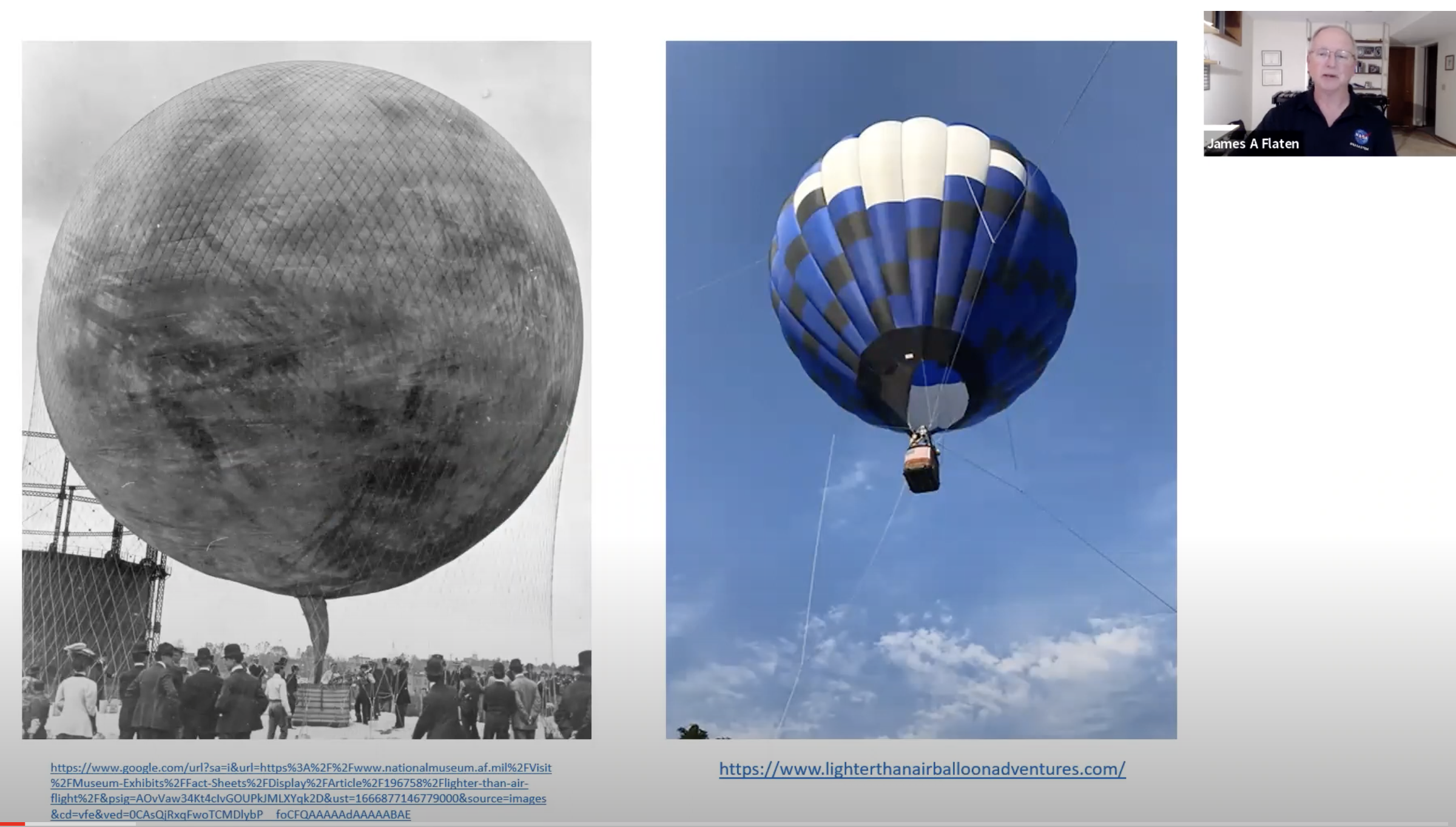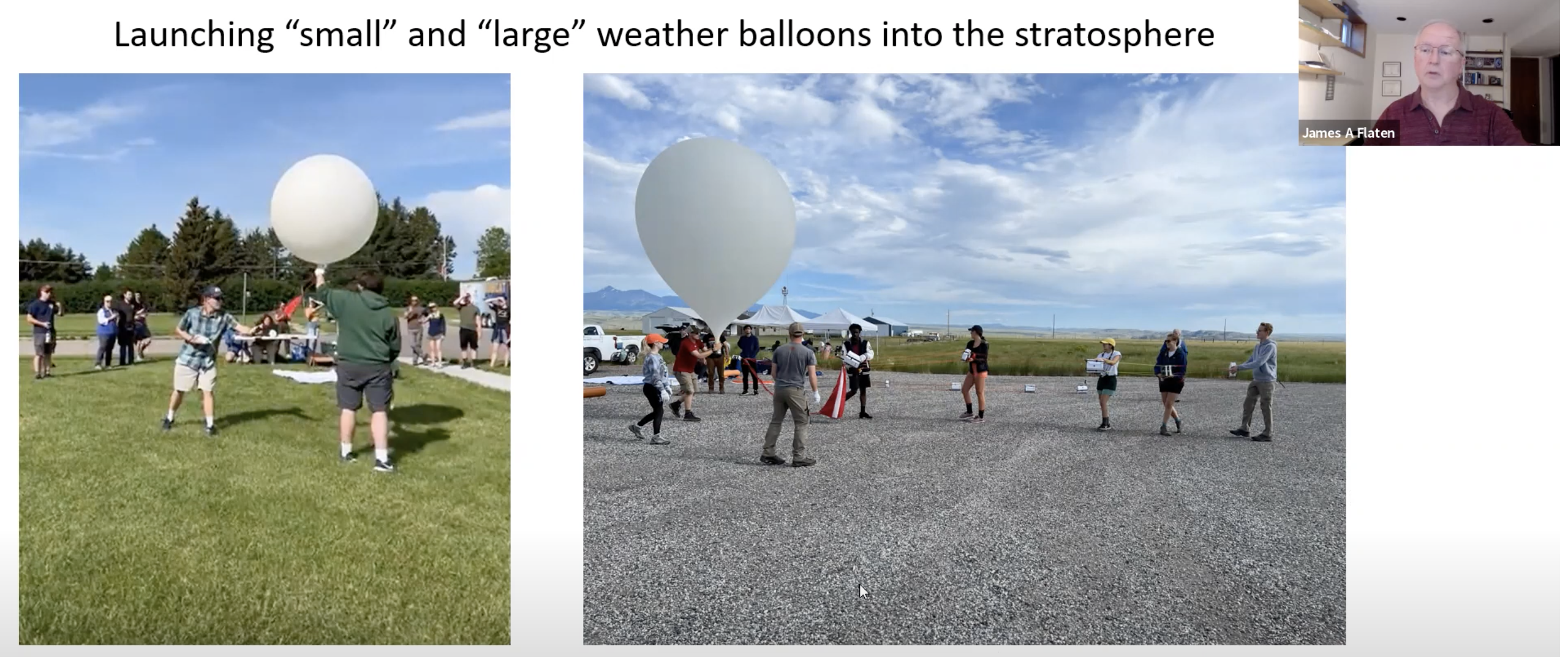Lesson 2: Introduction to Ballooning
This lesson serves as an introduction to ballooning for both the engineering and atmospheric science tracks. You will learn:
- terminology related to ballooning, such as envelope and lifting gas.
- some historical context, including balloons-carrying-people dating back to 1780s and airships of the early 1900s.
- the current types of balloons/ballooning: hot air, weather/rubber, zero-pressure, super-pressure.
- Pros and cons of lifting gas options: hot air, helium, hydrogen.
- Tethered vs free ballooning and Free vs powered/controlled ballooning.
Eventually, we will narrow the focus to stratospheric weather ballooning with preliminary information on payload development, flying the balloons (including trajectorypredictions, launching, GPS tracking (and other data telemetry), and recovery (if called for -- as you will learn, not all balloons are recovered).
Learning objectives
After completing this lesson, students will be able to:
- Define basic ballooning terminilogy
- Describe the different types of balloons used in high altitude ballooning
- Compare and contrast lifting gases, and
- Summarize the basic elements of a balloon flight.
Video content
Lighter-Than-Air-Ballooning
Lighter-than-air ballooning includes everything from flame-carrying "sky lanterns" (not a recommended activity) to the earliest balloon flights carrying people in 1783, to the amazing airships of World War II, to pico-balloons capable of circumnavigating the Earth (several times!) plus many other categories including rubber and mylar party balloons. This video will introduce you to the various types and their potential payloads. These presentation includes photos and descriptions of many types of balloons.

- Overview of Lighter-Than-Air Ballooning by Dr. James Flaten, Minnesota Space Grant Consortium, [YouTube video, 20:53]
- View/download the slide deck for this presentation [in our NEBP Google Drive]
Stratospheric Weather Ballooning
In the NEBP project, the atmospheric science balloons will carry small radiosondes to send weather information to a ground station, and the engineering balloons will carry video streaming payloads to capture the view from the stratosphere to the ground. We will fly during the eclipses of October 2023 and April 2024.

- Introduction to Stratospheric Weather Ballooning - by Dr. James Flaten, Minnesota Space Grant Consortium [YouTube video, 11:12]
- View / download the slide deck for this presentation [in our NEBP google drive]
Additional (optional) instructor materialStratospheric Ballooning for Educators: Getting Started by Dr. James Flaten, Minnesota Space Grant Consortium [YouTube video, 1:34:09; closed captioned |
Class activity
Ballooning and payloads
During class, you can inflate a small rubber balloon (and maybe a mylar balloon too) with lifting gas and practice measuring lift, sealing it, and tethering it.
You can also possibly measure lift vs time (over the course of ~24 hours) to document the fact that helium leaks through the balloon envelope, though probably not fast enough to bother the 2-3 hour flights of the NEBP project.
You can also start thinking about payloads. If a small camera is available - not necessarily even a telemetry camera - use the tethered balloon to lift a camera to get people to start thinking about the view (and the unstable platform).
Additional information
The NEBP project is part of the the NASA Science Activation Program, also known as SciAct. This is a cooperative network of competitively selected teams across the Nation that connect NASA science experts, real content, and experiences with community leaders to do science in ways that activate minds and promote deeper understanding of our world and beyond.
The NEBP project partners with and extends knowledge from many other SciAct projects, including (but certainly not limited to)
- Native Earth | Native Sky (NENS)
- The Eclipse Soundscapes Citizen Science Project (ES:CSP)
- AEROKATS/ROVER Education Network
- NASA Heliophysics Education Activation Team
- Navigating the Path of Totality
Learn more: What is NASA SciAct? [Web page]
Extended learning: My STEM Career
A very imortant component of NEBP -- or any field campaign or similar project -- is to document your work as you go along. You may have done this for a class before, such as a science lab book. Other people may call this a research journal, an engineering logbook, or other names. Not only will this help you throughout NEBP, but it can become a portfolio or your work and experiences that will be valuable when you apply for jobs or advanced educationl.
We encourage you to record a journal entry after the completion of each NEBP lesson in this series, although recording more often is even better -- such as when you learn a new skills, encounter a challenge or launch a balloon.
Will you take a few minutes to give us some feedback on this lesson? Thank you!
Atmospheric Science Team // Engineering Team
